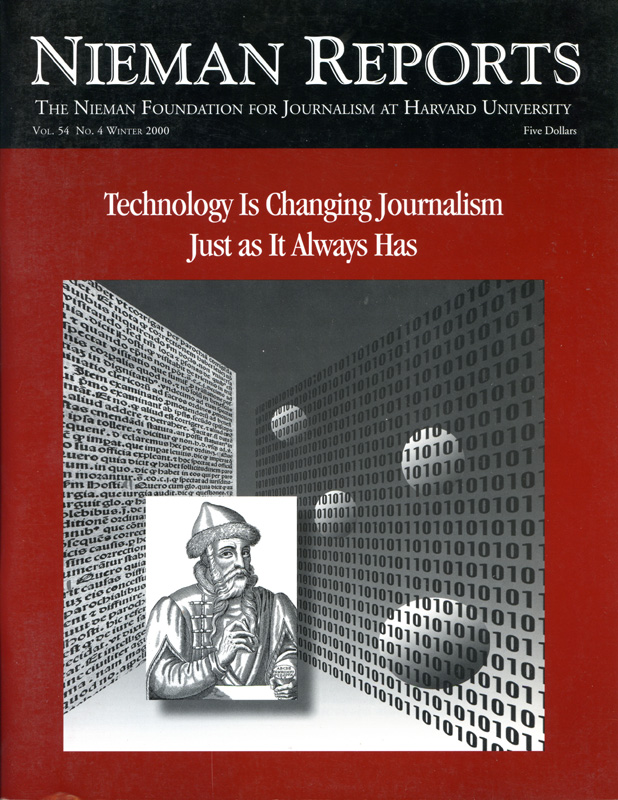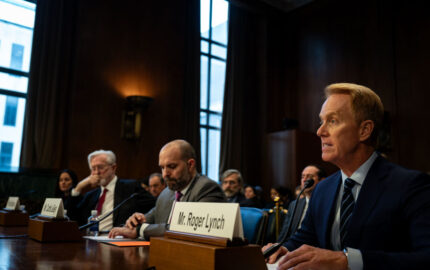
In much the way refrigeration changed food production and consumption, digitization potentially changes everything about the manner in which we produce and consume news. All presumptions about its freshness and perishability vanish.
For most of the 20th century, the public had to follow unfolding news, catching it as it presented itself or losing it forever. Any viewer who wanted to see a local story after its broadcast was simply out of luck. Newspapers and magazine readers had a slightly better chance of finding recently published articles, but locating large quantities of older reporting was the province of scholars or pricey research firms. Now, digital databases, most available through the Internet, turn that pattern upside down. The public needn’t pay attention all the time. Increasingly, it doesn’t.
Convergence of information media on digital platforms means anyone can be a scholar or editor. Friends are becoming more reliable filters of information than established news brands. Technology allows for more news, produced and available at lightening speed, often at lower costs than before. And the process is accelerating still, facilitated by equipment upgrades of Y2K remediation and government-mandated conversion to high-definition television, most of it digital. Whether or not the public embraces HDTV, television stations have hardware in place.
Journalists worry. Will quality suffer? Will commerce contaminate hard-won integrity?
Actually, the end of the journalists’ world is nowhere in sight. But as the digital revolution marches ahead, much about the ways we define, gather and produce news will have to change, too.
Quantity, Quality and Speed
Volumes of stories, delivered instantaneously, have changed America’s information diet. News is now less a series of discreet “meals,” a morning newspaper, a noon radio update, and an evening broadcast. Rather, it’s a robust, all-day buffet, containing fast food, junk food, fine dining, and everything in between. The public can choose to partake of what it wants, when it wants, in any format, and consume as much or as little as it desires. This system challenges consumers to select a balanced fare of entertainment and public interest offerings. In turn, news organizations must decide how much information to collect and how to package and present it.
On its best days, technology improves the news. Database reporting unearths important breaches of public trust, invisible without easy access to raw information and knowledge about how to use sophisticated computer programs to sort it out. Patterns of police brutality, discriminatory lending practices for homes or cars, and inequitable application of the death penalty are important public topics that have benefited from computer-assisted reporting. For all the fluff served up, the impact of these stories provides more than equal counterweight, although they have become a smaller part of a larger, diversified information business. The trick will be to protect enterprise journalism, to create a device akin to Al Gore’s famous “lock box” that distinguishes them from entertainment, e-commerce and a host of other sins that coexist in the digital cauldron.
On the other hand, digitization can impede quality. In quickening the journalistic process, layers of editing as well as production disappear. As a result, rumors are apt to make their way to the public more often. Because the Internet allows for instantaneous, continuous coverage, the concept of a news cycle has all but disappeared. So has the ability of a single executive to manage it.
Cycles of Consumption
Internet users have developed a pattern of news consumption that is different from adults who aren’t wired. They watch more cable but less broadcast news; they read more weekly papers and specialty magazines but fewer dailies and general interest publications. Between these groups, distinctions intensify with time. Internet users appear to be more intense consumers. They catch breaking news online or on cable; they read with less frequency but more depth, a practice enhanced by hyperlinks on the World Wide Web. Users tend to bypass incremental updates and common daily news fare, preferring the weekly overview or analysis. Theirs is a rhythm of attention in opposition to the current production cycles.
With this pattern falling into place and more than half the nation’s households plugged in, news media are due to rethink packaging and resource deployment. Full audience capacity for interactivity is a key but unknown variable.
Production Costs
Cost will determine how closely production patterns adapt to these changing styles of consuming news. Photos of the winning World Series home run arrived at editors’ desks within seconds. There was no film to transport or processing required. Just a phone line or cellular connection. The savings are huge. Technology also extracts large chunks of cost from broadcast field operations, miniaturizing equipment and staffing needed to operate it. Transportation and shipping expenses also fall sharply as a result.
Newspapers save untold billions automating front-end production systems, all but eliminating typesetting and page makeup departments. Now, the industry awaits technical solutions to post-production operations. Integrating customer databases with mail room and distribution units is an anticipated next step. Consumers place high value on choice, even in a mass medium. The Arizona Republic has 70,000 subscribers who pay an extra dollar a week not to receive Sunday advertising inserts. But its systems can’t yet put together the customized print product many readers crave.
Ultimate Convergence
In media talk, convergence refers to a receiving device: the computer, television, cable box top, telephone, or satellite dish. But what about convergence of function? What about the newsroom and convergence?
Because of regulatory waivers, the Belo Corporation in Dallas and Tribune Company in Chicago own daily newspapers, broadcast television stations, cable news channels and Internet sites, with overlapping staffs and facilities. More cities are seeing converged news organizations as partnerships form among different companies and the newspaper industry challenges the FCC’s (the Federal Communications Commission) prohibition of television and newspaper ownership in a single market.
News staffs work across media. Newspaper reporters also appear on cable news or television programs. Broadcasters write or produce stories for the Internet. Camera operators simultaneously shoot videotape for television and digital stills for publication but both are also available for the Web site. Can a single newsroom that merges these functions become the standard?
A merged newsroom already exists in Tampa. And Bloomberg, the financial reporting company, was a pioneer in setting up a single, digital newsroom for its various Wall Street and consumer information products. MSNBC’s cable network and Web site run convergent newsrooms in metropolitan New York and in Redmond, Washington. They support each other, as well as NBC network news and CNBC, the business network.
To help prepare for this future, the California-based Robert C. Maynard Institute for Journalism Education has begun cross-media training. Here, journalists are taught to design a newspaper’s front page, produce a five-minute broadcast, and build a Web site.
Moore’s Law vs. Murphy’s
Clearly, convergence will come. Unless, that is, it won’t.
Unchallenged new wisdom—Moore’s Law—asserts computer power doubles every 18 months. Whether it does or not, Murphy’s Law shows up regularly in the news industry’s march to its digital future. Often, logical outcomes never arrive. E-commerce makes sense, but the bricks and mortar distribution support for online sales proved to be a surprise. Similarly, online advertising on traditional media sites made sense, except there was no sales and marketing infrastructure to support it—no agencies, no accepted audience measurements, no efficient way to purchase. Similarly, the single, cross-media digital newsroom makes sense, but there are cultural, aesthetic and technical impediments. Not all journalists can do all jobs. If they could, not all should. Different skills underpin effective storytelling in television and print. Successful convergence requires deftly defined distinctions.
While digital convergence may not develop as imagined today, its effects are powerful and lasting. Best case, industry visions come true, or something approximating them will. Worst case, consumption patterns continue to change but insufficient infrastructure grows to support traditional values or providers. Preservation of journalistic standards will require content and technology to come together in a coherent way. Will they? Stay tuned.
Nancy Hicks Maynard is president of Maynard Partners, Inc., a consulting company. Maynard is the former co-owner and publisher of the Oakland (Calif.) Tribune. She has covered domestic policy for The New York Times in New York and Washington and education for The New York Post. Her book, “Mega Media,” was recently published by Trafford Publishing.


